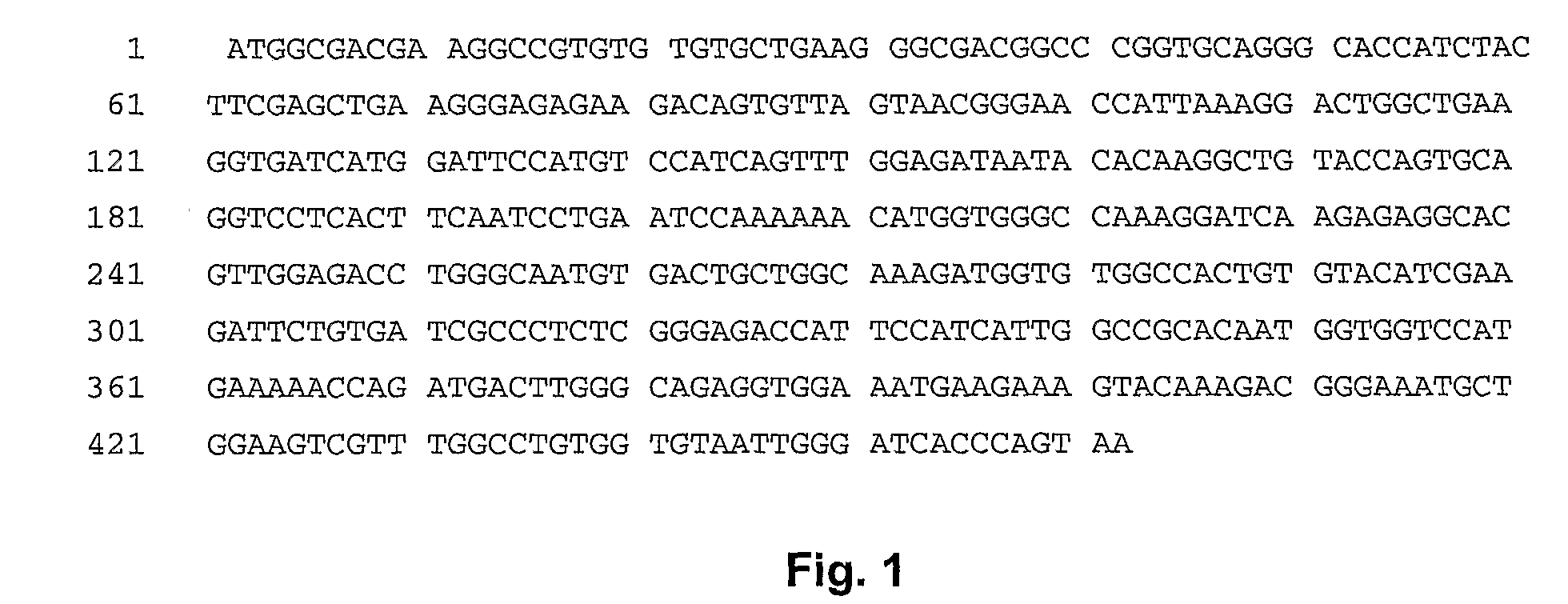Transgenic pig model for a hereditary neurodegenerative autosomal dominant disease
a technology of autosomal dominant disease and transgenic pig, which is applied in the field of transgenic pig model for hereditary neurodegenerative autosomal dominant disease, can solve the problems of inability of affected individuals to propagate, disappearance from the population, and limited value of animal models for many human diseases
- Summary
- Abstract
- Description
- Claims
- Application Information
AI Technical Summary
Benefits of technology
Problems solved by technology
Method used
Image
Examples
example 1
Transgenic Porcine Model of Amyotrophic Lateral Sclerosis (ALS)
[0294]In order to establish transgenic pigs which could serve as potential animal models for the human neurodegenerative disease ALS, a mutation, Gly93Arg, was introduced into the gene encoding porcine SOD1 by means of site directed mutagenesis. The choice of mutation was based on protein structural speculations, since the crystal structure of human SOD1 reveals an extremely condensed structure, showing that a substitution of the small relatively flexible glycine at position with the large charged arginine is likely to cause severe alteration in the protein. Furthermore, several different substitutions at this position cause ALS in humans including the G93R mutation [45,46]. In order to impede possible truncation of important elements in the DNA construct following the SMGT procedure the DNA fragment containing the porcine SOD1 cDNA contains additional nucleotides 5′- and 3′-prime to the CMV promoter and SVpolyA fragment...
example 2
A Transgenic Pig Model for Parkinson's Disease
Cloning of the Porcine SNCA cDNA
[0370]The full-length porcine α-synuclein (SNCA) cDNA was isolated from cerebellum by a combination of RT-PCR and RACE. Initially, blast searches using the human SNCA cDNA sequence were carried out with GenBank (http: / / www.ncbi.nlm.nih.gov / Genbank / index.html) and with the porcine EST data bank at The Danish Institute of Agricultural Sciences (DIAS). Sequence similarity search was performed with gapped alignment using NCBI Blastall with options blastn, minimum value 10-8. The porcine cDNAs thus identified were used to derive oligonucleotide primers for cloning and as queries for further searches in the local genomic DIAS sequence database.
[0371]The pig cerebellum tissue used for RT-PCR cloning of porcine SNCA was obtained from an adult pig. After removal, tissue was dissected and pulverized in liquid nitrogen. Total RNA was isolated by the RNeasy method (Qiagen). The integrity of the RNA samples was verifie...
example 3
A Transgenic Pig Model Animal of Alzheimer's Disease
PSEN1 and PSEN2 Isolation and Sequencing
[0432]Pig brain, lymphocyte, and liver RNA was isolated with the TRI-reagent (Sigma). For RT-PCR of PSEN1 the following primers were used (PSEN1forward, 5′-TGGAGGAGAACACATGAAAGAAAG-3′ (SEQ ID NO: 95); PSEN1-forward-EcoR1 5′-GGGGAATTCTGGAGGAGAACACATGAAAGAAAG-3′ (SEQ ID NO:96); PSEN1reverseEcoR1, 5′-GGGGAATTCCCTGACTTTGTTAGATGTGGACAC-3′ (SEQ ID NO:97). The RT-PCR reaction was incubated at 50° C. for 60 min with the reverse primer followed by PCR with the PSEN1forward-EcoR1 and PSEN1 reverse-EcoR1 primers at conditions (94° C. for 3 min, 35 cycles of; 94° C., 45 sec; 62° C., 30 sec; 68° C., 2 min, followed by a final elongation step at 68° C. for 7 min). Amplified DNA fragments were purified from agarose gels and either directly sequenced or EcoR1 cloned into pCDNA3 followed by DNA purification and sequencing. For RT-PCR of PSEN2 the following primers were used (PSEN2-forward, 5′-GCCATGCTCACTTTCA...
PUM
 Login to View More
Login to View More Abstract
Description
Claims
Application Information
 Login to View More
Login to View More - R&D
- Intellectual Property
- Life Sciences
- Materials
- Tech Scout
- Unparalleled Data Quality
- Higher Quality Content
- 60% Fewer Hallucinations
Browse by: Latest US Patents, China's latest patents, Technical Efficacy Thesaurus, Application Domain, Technology Topic, Popular Technical Reports.
© 2025 PatSnap. All rights reserved.Legal|Privacy policy|Modern Slavery Act Transparency Statement|Sitemap|About US| Contact US: help@patsnap.com



